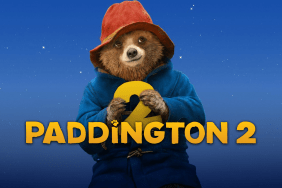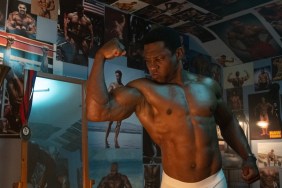Smile director Parker Finn came back with an even larger and more twisted sequel. Now available on digital, Smile 2 stars Naomi Scott in the lead role and features some incredible moments. Finn discussed filming some of the horror movie’s key scenes with ComingSoon Editor-in-Chief Tyler Treese.
“About to embark on a new world tour, global pop sensation Skye Riley (Naomi Scott) begins experiencing increasingly terrifying and inexplicable events. Overwhelmed by the escalating horrors and the pressures of fame, Skye is forced to face her dark past to regain control of her life before it spirals out of control,” says the synopsis for Parker Finn’s sequel.
Tyler Treese: I wanted to ask you about the opening with Kyle Gallner. It’s great connective tissue, obviously, but it almost feels like a totally different genre. It’s this very tense action thriller. You really get to show some range there. What did you like most about just setting the tone with this very dramatic, very intense opening?
Parker Finn: Well, thank you, first of all. I knew that this second film was such a big swing that it was gonna have its own sort of identity and feel. The world of Skye Riley was gonna feel so sort of disparate from the first one. So I wanted to have that connective tissue, both for narrative means and also to just connect the two worlds, but at the same time, I wanna make sure that we were sort of coming outta the gate with a bang, with something that felt totally different than anything we’d seen in the first film.
I love Kyle Gallner. We became really good friends working on the first one, and I was very excited to get to bring him back. From the point when I was writing it, I knew that I wanted that opening sequence to sort of unfold in a single unbroken take. Because I knew it really would add to the claustrophobia, the stress that the character is feeling, and how it just keeps getting worse and worse, and things keep going wrong. It felt like a really exciting idea. We went into it thinking, “Hey, this is something that can almost stand-alone, like its own short film that feels sort of like action thriller-y, but also is like announcing, ‘Hey, Smile is back, and it’s meaner than ever.'”
I wanted to also ask you about the hallway scene. It became instantly iconic in the trailers, and it really delivers in the full film. I was curious about the logistics of filming something like that. Is it more almost like choreography or like a fight scene?
Thank you very much. That was a very exciting scene to take on. It also freaked me out because it was, again, something that, when I was writing it, I knew if we executed it correctly, it could almost transcend the genre and become its own unique thing. But it was gonna walk that line. Because if we didn’t nail it, it was just gonna fall on its face. So, we set up Skye’s choreography throughout the film, always knowing that it’s gonna lead us towards this scene.
So, yes, this scene was fully choreographed. I worked with my choreographer, Celia Rowlson-Hall, and several of the troupe in there are from her backup dancers as well. So there’s that continuity. We always talked about it almost feeling like… I was curious to see if I could do something that felt just as much Hideo Nakata as it does Bob Fosse, you know? So we talked about like All That Jazz and that sort of thing.
But the trick of it was creating this red light, green light game that instantly the Smiler starts cheating at. So you can’t quite wrap your hands around the rules of it. The trick was that Naomi was at the center of this choreography, but for her, it needed to feel like she was just reacting and not performing the steps of what really is almost like a dance. I’m really excited about how it came together and how it starts playful and creepy but then takes this turn and becomes incredibly violating, violent, awful, and nightmarish. It was a really exciting scene to shoot. You could sort of tell everybody was gathered around the monitor on set, like, “Holy s—. This is something different.”
You mentioned the Smiler breaking the rules, and I wanted to ask you about just the usage of rules within the film because people can get really bogged down on the specifics of what the demon can do and what the rules are to this universe. How do you balance that with just wanting to surprise the audience and have it work thematically?
Well, I take that as such a compliment when people obsess over those details. So, there’s a couple things I’ll say. First is that in the film, there are sound internal rules and logic at work, but just because we’ve seen the first film doesn’t mean we know everything about the Smiler. So, in talking with my producers and stuff, we sort of have all this information that we know about the Smiler that then informs what happens in the film, but we don’t give the audience everything, or at least we don’t spoonfeed it. But especially upon rewatch, there’s stuff, there are clues along the way, and it was important to me that each character that interacts with it sort of has a different relationship with it.
At the same time for me, I’m always interested in the character’s story. This is an intensely psychological film that really places you inside the head of a character. So what I really am chasing is emotional truth. That’s the thing that matters the most to me. That’s the thing that I think we take away from the movie more than anything is Skye’s journey through the film. So it’s about balancing the rules and the lore and making sure that that doesn’t become a trap that we get bogged down in, but something that is sort of this machine that Skye has been put inside, but that our focus is really about Skye’s emotional state and her emotional journey.
I wanted to ask about the audition process for you because the smile is such a particular thing. Have you ever had anybody who was really good for a role but just could not get the smile down?
For me, when I do cast, I’m always casting for a performance, knowing that the smile is something I can coach down the road. I think that the smile is actually less difficult than people think it is. But it’s just about doing things really specifically. The way it works is to have people do a slightly too wide smile, but something that you would still consider friendly, right? Imagine you’re posing for a photo with friends. It’s that sort of smile, but it’s about disconnecting the eyes from it.
The eyes are really the trick about the smile, and it’s kind of this very dead-eyed, unblinking stare. We do a little bit of head positioning, sort of hearkening back to the Kubrick stare. We were almost looking up from underneath your brow a little bit. It’s really about that. Then, mixed with the framing, the color palette, the sound design, and all that stuff coming together, can create a really unsettling moment.
Some actors come in really prepared, and I can tell they’ve been practicing. Other ones come in terrified of the smile. It’s the thing that scares them the most. Then it’s usually just about us going into a mirror and sort of doing it together and really getting them to understand it.
Thanks to Parker Finn for taking the time to talk about Smile 2.











